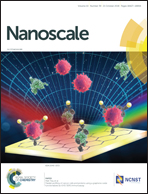DNA-encircled lipid bilayers†
Abstract
Lipid bilayers and lipid-associated proteins play crucial roles in biology. As in vivo studies and manipulation are inherently difficult, membrane-mimetic systems are useful for the investigation of lipidic phases, lipid–protein interactions, membrane protein function and membrane structure in vitro. In this work, we describe a route to leverage the programmability of DNA nanotechnology and create DNA-encircled bilayers (DEBs). DEBs are made of multiple copies of an alkylated oligonucleotide hybridized to a single-stranded minicircle, in which up to two alkyl chains per helical turn point to the inside of the toroidal DNA ring. When phospholipids are added, a bilayer is observed to self-assemble within the ring such that the alkyl chains of the oligonucleotides stabilize the hydrophobic rim of the bilayer to prevent formation of vesicles and support thermotropic lipid phase transitions. The DEBs are completely free of protein and can be synthesized from commercially available components using routine equipment. The diameter of DEBs can be varied in a predictable manner. The well-established toolbox from structural DNA nanotechnology, will ultimately enable the rational design of DEBs so that their size, shape or functionalization can be adapted to the specific needs of biophysical investigations of lipidic phases and the properties of membrane proteins embedded into DEB nanoparticle bilayers.



 Please wait while we load your content...
Please wait while we load your content...